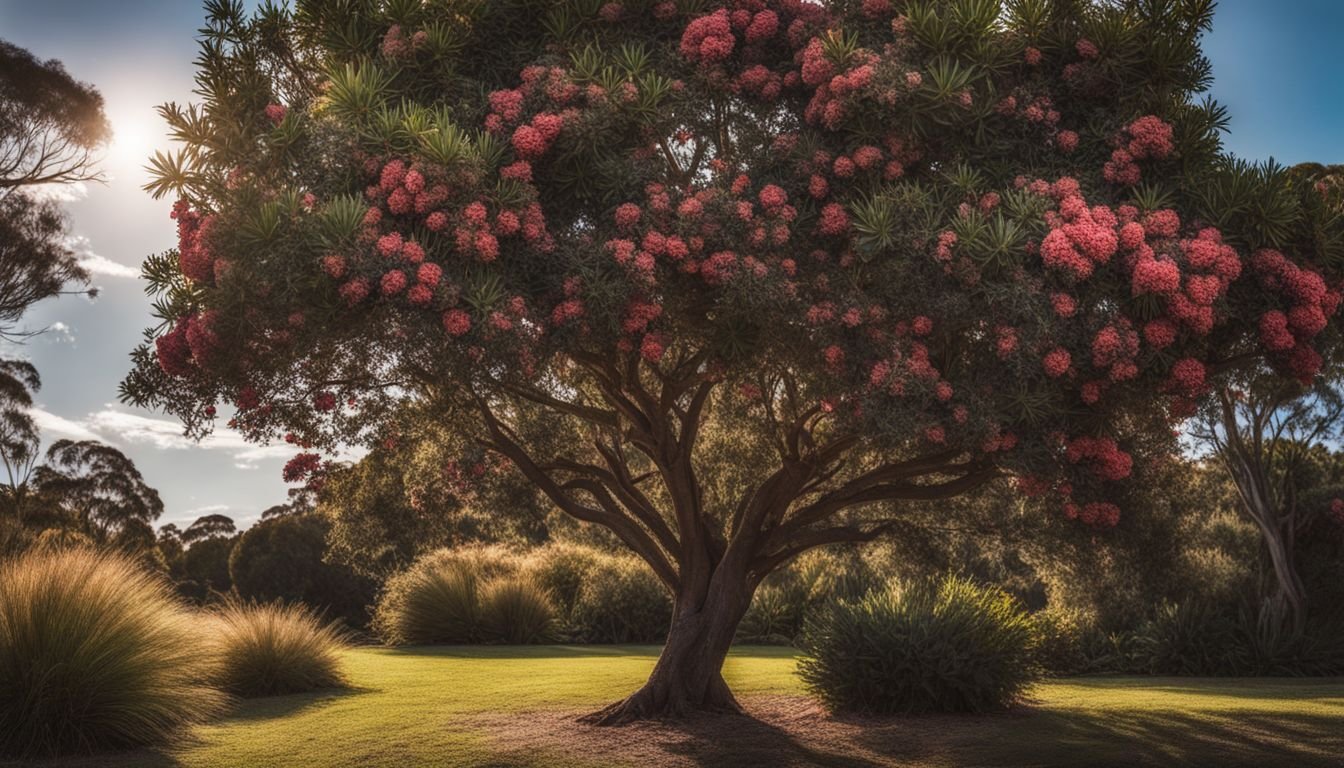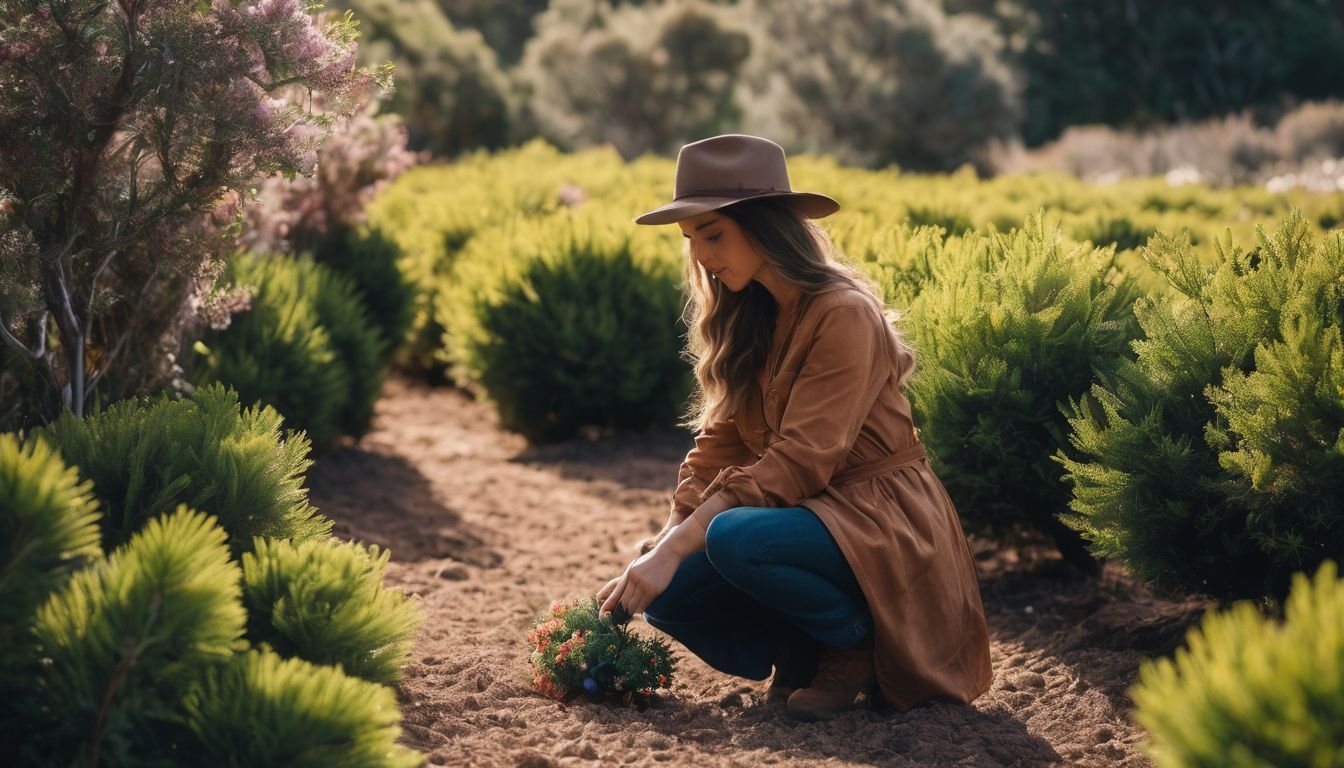Many of us are keen as mustard to bring a slice of the unique Australian beauty into our gardens, especially when the festive season is around the corner. Yet, tracking down a plant that doesn’t just chuck a wobbly in our varied Aussie climates but also chucks in that special holiday cheer can feel like searching for a needle in a haystack.
We’ve all faced this head-scratcher – scouting for something truly Aussie to make our yards pop come Christmas time. The good news? You’re not flying solo on this mission. After a fair dinkum deep dive into research and drawing from yarns about personal run-ins with native plants, I stumbled upon an absolute ripper – the Australian Christmas Bush (Ceratopetalum gummiferum ‘Alberys Red’).
This beaut evergreen tree is the spirit animal of Aussie Christmases through and through, what with its eye-catching red bracts and white flowers blooming smack bang in December’s heart.
It’s not just any bushy beacon of joy though; it’s tough as nails too, flourishing from New South Wales scrubbies right over to Canberra’s nippier nooks. Our guide’s gonna walk you through everything – planting your footsie right up to soaking up its full splendour throughout Chrissy and beyond.
Count on deadset clear steps on how to grow this native knockout successfully, plus hacks on turning it into the show pony of your festive decorations.
Let’s get stuck into making our gardens sparkle with true blue Aussie spirit, hey!
Key Takeaways
- The Australian Christmas Bush, or Ceratopetalum gummiferum ‘Alberys Red’, transforms from white flowers to vibrant red bracts in December, giving Aussie gardens a festive look.
- It thrives in light, well – drained soil and can adapt to full sun or partial shade, making it versatile for various garden setups across Australia.
- Planting this bush involves choosing the right location with ample sunlight, improving clay soil with organic matter for better drainage, and using specific fertilisers suited for native plants to ensure healthy growth.
- This plant attracts native wildlife such as butterflies, moths, and bees to your garden by offering nectar-rich flowers while also being perfect for cut decorations inside your home during Christmas.
- By following simple care tips tailored to local conditions like avoiding overwatering and pruning after flowering ends, you can enjoy its beauty every year as it becomes an established highlight of your garden.
Revealing the Beauty of the Australian Christmas Bush

We’ve just explored the fascinating overview of the Australian Christmas Bush, now let’s delve into its unique beauty that captivates gardeners and plant enthusiasts alike. The Australian Christmas Bush, particularly Ceratopetalum gummiferum ‘Alberys Red’, showcases an eye-catching transformation as it blooms.
Initially, its flowers are white, creating a serene appearance against the green foliage. However, as December approaches – aligning perfectly with festive celebrations – these transform into vibrant red bracts.
It’s this stunning colour change that makes it a centerpiece in many Aussie gardens during Christmas time.
Not only does this bush serve as a spectacular visual treat but also plays an integral role in native gardens or as a standout specimen tree. Its ability to thrive in light, well-drained soil under full sun to partly shaded conditions means it can adapt to various garden settings.
Furthermore, growing up to 4m in height and 2m wide when mature adds an impressive presence outdoors. Whether planted directly in the ground or potted for those who prefer portable seasonal decor, the NSW Christmas bush brings joy with its bright red-pink hues celebrating the spirit of Christmas right at your doorstep.
A Comprehensive Guide to Growing the Australian Christmas Bush

We’ll walk you through every step needed to grow a thriving Australian Christmas Bush in your own garden. From selecting the perfect spot to understanding the care requirements, our guide ensures your success with this native beauty.
Ideal Climate and Soil Conditions
The Australian Christmas Bush flourishes in conditions that mimic its natural habitat. Light, well-drained soil provides the perfect foundation for growth, while locations that offer a mix of sunny and partly shaded spots ensure the plant thrives.
Especially during La Niña cycles, cooler summers paired with regular rainfall extend the flowering season, bringing out the best in these native plants. Whether it’s the New South Wales Christmas bush or its Tasmanian counterpart, they all share this preference for their growing environment.
Properly preparing clay soils can significantly impact your Christmas Bush’s health and flowering capabilities. Incorporating organic matter into clay soils improves drainage and aeration, creating an ideal setting for roots to spread without waterlogging issues.
Frost tolerance once established makes them a robust choice even in cooler areas like Canberra, demonstrating their adaptability across different regions of Australia. Remember to protect young plants from frost until they are fully established.
Maintaining optimal soil moisture levels without overwatering is key to preventing common pests such as sooty mould and scale insects which thrive on stressed plants. Utilising organic mulch not only retains soil moisture but also gradually enriches soil structure over time as it decomposes.
This approach keeps your Australian Christmas bushes healthy and vibrant throughout their blooming season whilst enhancing your garden’s overall ecosystem.
Planting and Fertiliser Recommendations
Getting the Australian Christmas Bush to thrive in your garden is a rewarding pursuit. Here, we share essential tips on planting and applying fertiliser that ensure this festive plant reaches its full potential.
- Choose a spot in your garden that receives full sun to partial shade. This ensures the bush gets enough light while being protected during the hottest part of the day.
- Select light, well – drained soil for planting. The Tasmanian and Victorian Christmas Bush varieties, including bursaria spinosa and prostanthera lasianthos, flourish under these conditions.
- Consider the timing of planting carefully. Early spring is ideal as it gives the plant time to establish itself before the warmer months.
- Dig a hole twice as wide and just as deep as the root ball of your Christmas Bush. This provides ample room for roots to spread without stress.
- Incorporate a quality potting mix with your native soil when planting. This improves drainage and provides initial nutrients for growth.
- Water deeply immediately after planting. Continue with deep watering once or twice a week during hot and dry conditions, as recommended by experts.
- Apply a slow – release fertiliser specific for native plants at the beginning of spring. These are formulated to meet the nutritional needs of Australian natives like the Christmas Bush without overwhelming them.
- Monitor for signs of dieback and mistletoes which can indicate health issues. Early detection allows for prompt action to save affected plants.
- Pruning is advisable after flowering to maintain shape and encourage denser growth next season. Use clean, sharp tools to make precise cuts.
Enjoying the Beauty and Benefits of the Australian Christmas Bush
We often marvel at the vibrant red shades of the Australian Christmas Bush, a spectacle that brings festive cheer to our gardens every December. Its creamy white flowers surrounded by red bracts not only capture the essence of an Aussie Christmas but also create a picturesque setting in native gardens or as a standalone specimen tree.
Imagine stepping outside to a garden that’s alive with colors matching the holiday season’s spirit, making it the perfect backdrop for family celebrations and gatherings.
Incorporating this plant into your garden offers more than just aesthetic pleasure; it invites a bustling ecosystem right to your doorstep. Native butterflies, moths, and bees are drawn to its nectar-rich flowers, turning your garden into a haven for these essential pollinators.
We take pride in knowing our gardening choices support local wildlife while enhancing biodiversity. Moreover, considering its suitability for cut flowers means we can bring its unique beauty indoors.
Picture setting your Christmas table with vases filled with branches from your very own bush – it’s both sustainable and deeply personal.
Caring for this small tree rewards us in numerous ways beyond its decorative appeal during the festive season. By following simple cultivation tips suited to South Australian and Tasmanian conditions such as well-drained soil and partial shade locations, we ensure our Australian Christmas Bush thrives alongside us for many years to come.
Each year, as December approaches and those distinctive blooms begin to show, we’re reminded of nature’s incredible ability to mark seasons and festivities in beautiful ways that resonate with Australians’ love for their natural heritage.
Additional Resources on Plants (Including the Australian Christmas Bush)
Expanding our knowledge on the Australian Christmas Bush, including its varieties like the Tasmanian and South Australian Christmas bush, enriches our gardening experience. We dive into resources that unveil its unique characteristics, such as the bright red-pink sepals flourishing around Christmas.
These guides also shed light on effective cultivation methods and introduce related native plants worth exploring, like the Stenocarpus Firewheel Tree and Illawarra Flame Tree.
Exploring other resources helps us discover how to attract honeydew-producing critters, enhancing plant health and backyard biodiversity. Botanists have compiled a wealth of information for hobbyists and professionals alike, offering insights into nurturing these native beauties in pots or gardens.
This journey through additional materials not only broadens our understanding but also fuels our passion for Australia’s exquisite flora.
Conclusion
Embracing the Australian Christmas Bush in your garden offers a unique touch to the holiday season, with its vibrant red-pink sepals and creamy white flowers. Not only does it enhance your outdoor space, but it also supports local wildlife, including butterflies, moths, and bees.
Following our guide ensures you can grow this native beauty successfully, making every Christmas truly special. Let’s celebrate the festive season by bringing a piece of Australian nature into our homes with the Australian Christmas Bush.
Cherish this plant’s enduring charm as a symbol of joy and natural beauty during our beloved festive period.
FAQs
1. What is the Australian Christmas Bush?
The Australian Christmas Bush refers to native plants found in South Australia and Tasmania, celebrated for their vibrant blooms around the holiday season.
2. Can I grow a Tasmanian Christmas Bush in my garden?
Absolutely! With proper care, you can successfully cultivate a Tasmanian Christmas Bush. It requires well-drained soil and a sunny spot to thrive.
3. How do I care for my South Australian Christmas Bush?
Caring for your South Australian Christmas Bush involves regular watering, especially during dry spells, and pruning after flowering to encourage growth and maintain its shape.
4. Why are these bushes called “Christmas” bushes?
These bushes earn their festive name because they burst into bright colors around December, adding natural beauty to the holiday season with their cheerful presence.
